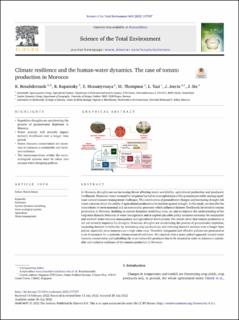| dc.contributor.author | Benabderrazik, Kenza | |
| dc.contributor.author | Kopainsky, Birgit | |
| dc.contributor.author | Monastyrnaya, Elena | |
| dc.contributor.author | Thompson, William | |
| dc.contributor.author | Tazi, L. | |
| dc.contributor.author | Jörin, Jonas | |
| dc.contributor.author | Six, Johan | |
| dc.date.accessioned | 2022-08-12T12:27:46Z | |
| dc.date.available | 2022-08-12T12:27:46Z | |
| dc.date.created | 2022-08-11T07:10:20Z | |
| dc.date.issued | 2022 | |
| dc.identifier.issn | 0048-9697 | |
| dc.identifier.uri | https://hdl.handle.net/11250/3011660 | |
| dc.description.abstract | In Morocco, droughts are an increasing threat affecting water availability, agricultural production and producers' livelihoods. Moreover, water demand for irrigation has led to overexploitation of the groundwater table causing significant natural resource management challenges. The combination of groundwater changes and increasing drought risk raises concerns about the ability of agricultural producers to be resilient against drought. In this study, we describe the interactions of environmental and socioeconomic processes which influence farmers' livelihoods involved in tomato production in Morocco. Building on system dynamics modelling tools, we aim to improve the understanding of the long-term dynamic behavior of water management and to explore plausible policy scenarios necessary for sustainable and resilient water resource management and agricultural development. Our results show that tomato production is not yet severely impacted by droughts. However, droughts are accelerating the process of groundwater depletion, impacting farmers' livelihoods, by decreasing crop productivity and reducing farmer's revenue over a longer time period, especially since tomatoes are a high-value crop. Therefore, integrated and effective policies are presented as a set of measures for a systemic enhancement of resilience. We conclude that a more radical approach toward water resource conservation and upholding the most vulnerable producers has to be adopted in order to enhance a sustainable and inclusive resilience of the tomato production in Morocco. | en_US |
| dc.language.iso | eng | en_US |
| dc.publisher | Elsevier | en_US |
| dc.rights | Navngivelse 4.0 Internasjonal | * |
| dc.rights.uri | http://creativecommons.org/licenses/by/4.0/deed.no | * |
| dc.title | Climate resilience and the human-water dynamics. The case of tomato production in Morocco | en_US |
| dc.type | Journal article | en_US |
| dc.type | Peer reviewed | en_US |
| dc.description.version | publishedVersion | en_US |
| dc.rights.holder | Copyright 2022 The Author(s) | en_US |
| dc.source.articlenumber | 157597 | en_US |
| cristin.ispublished | true | |
| cristin.fulltext | original | |
| cristin.qualitycode | 2 | |
| dc.identifier.doi | https://doi.org/10.1016/j.scitotenv.2022.157597 | |
| dc.identifier.cristin | 2042324 | |
| dc.source.journal | Science of the Total Environment | en_US |
| dc.identifier.citation | Science of the Total Environment. 2022, 849, 157597. | en_US |
| dc.source.volume | 849 | en_US |

